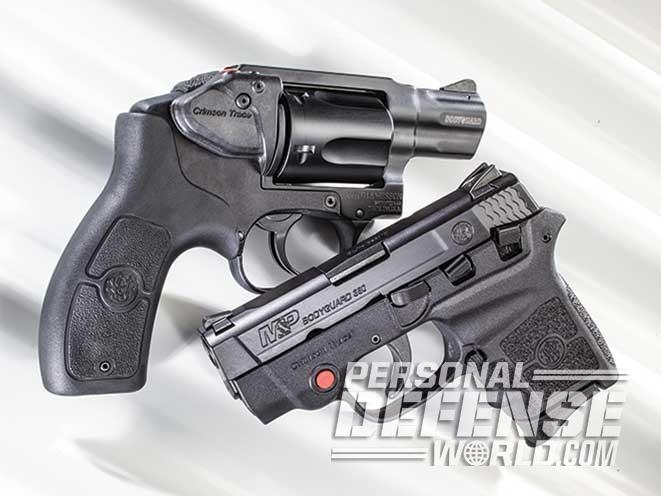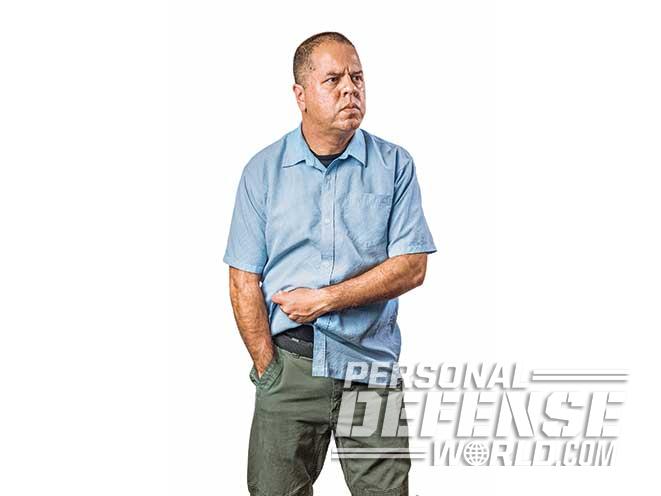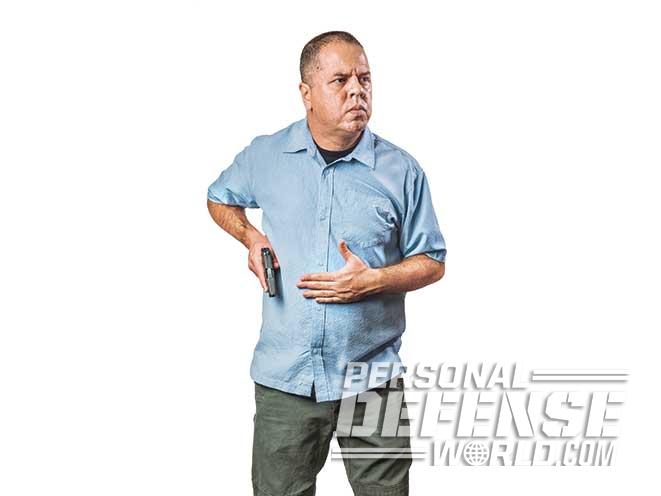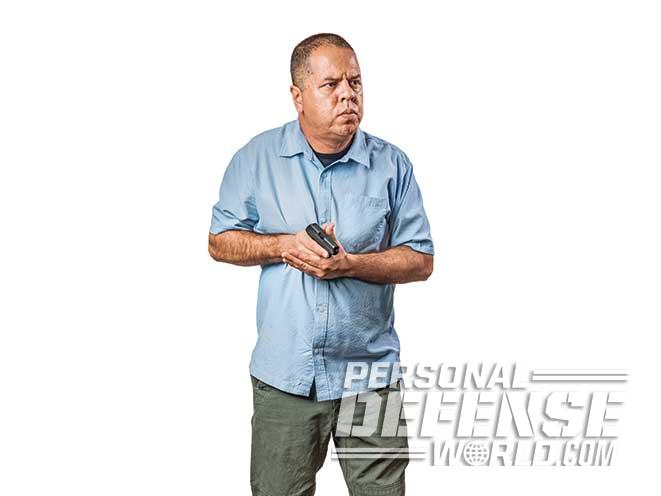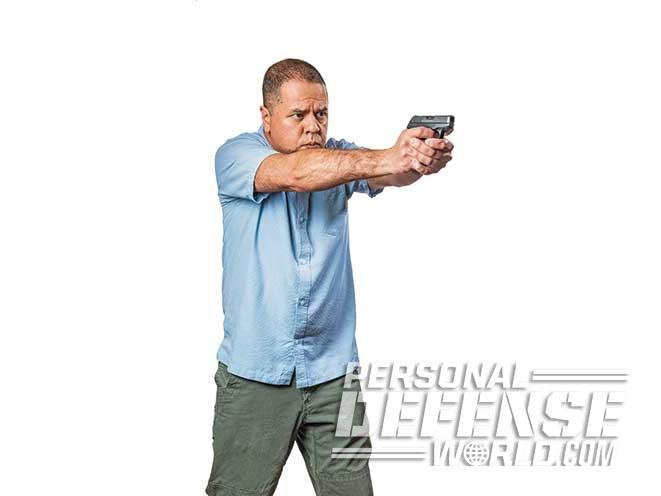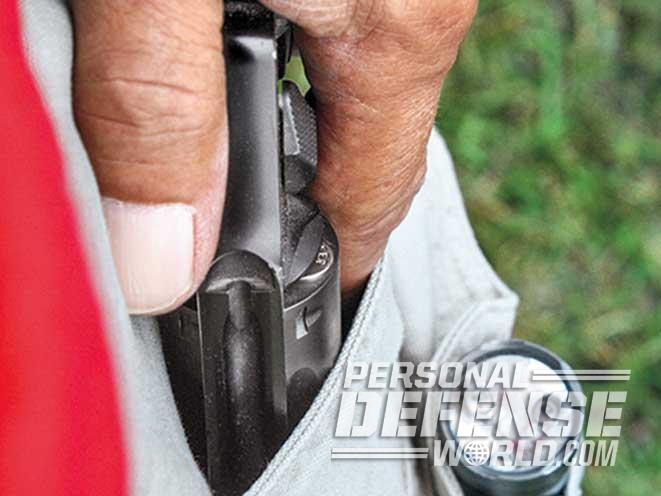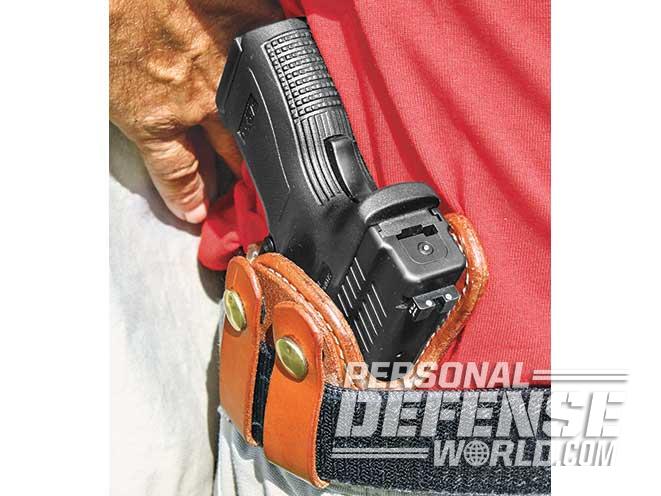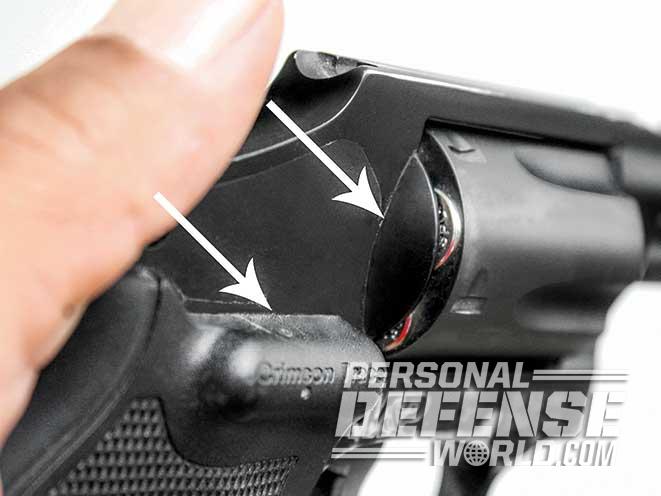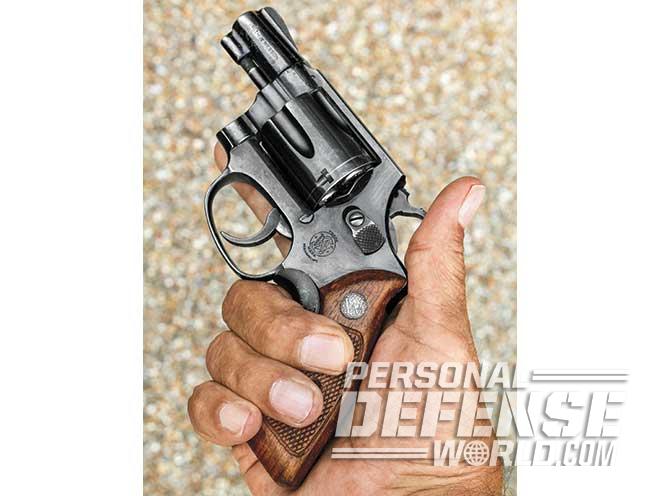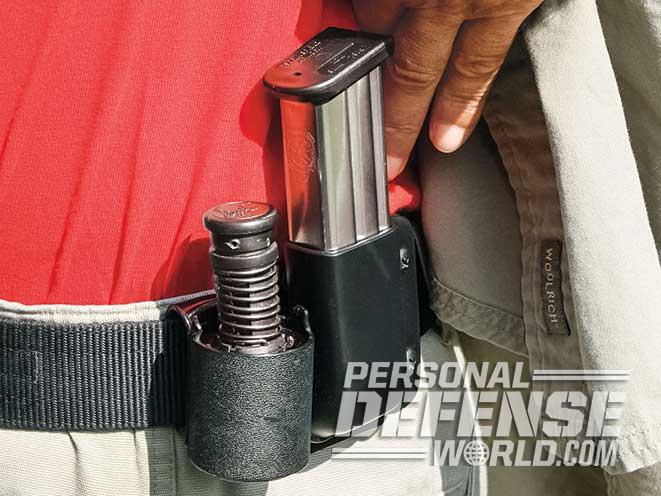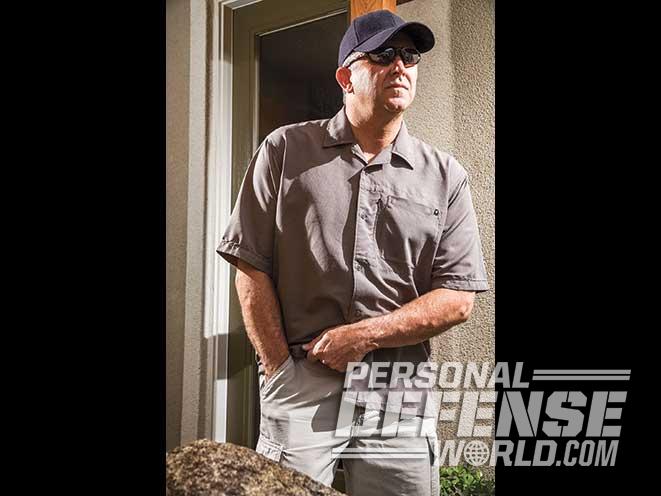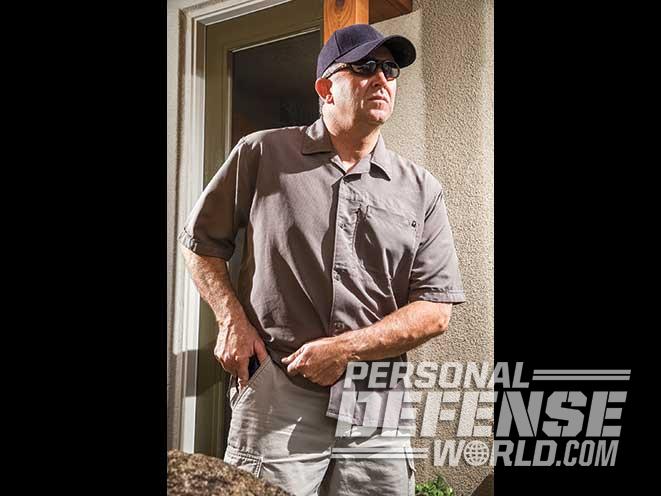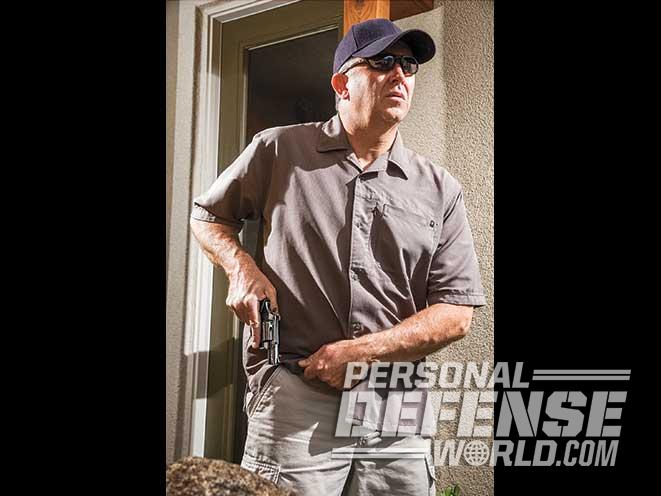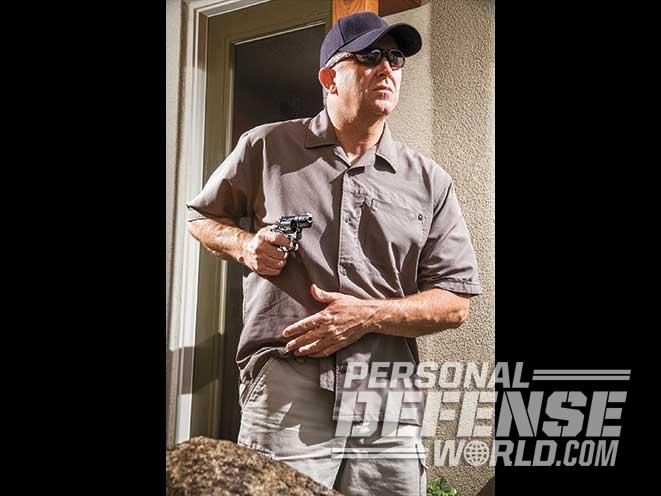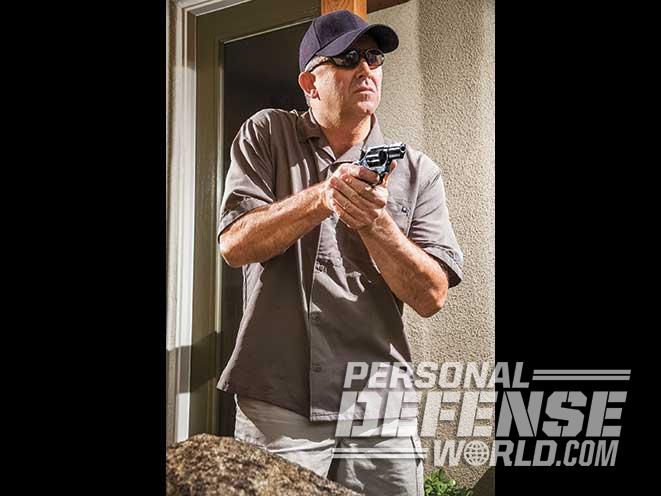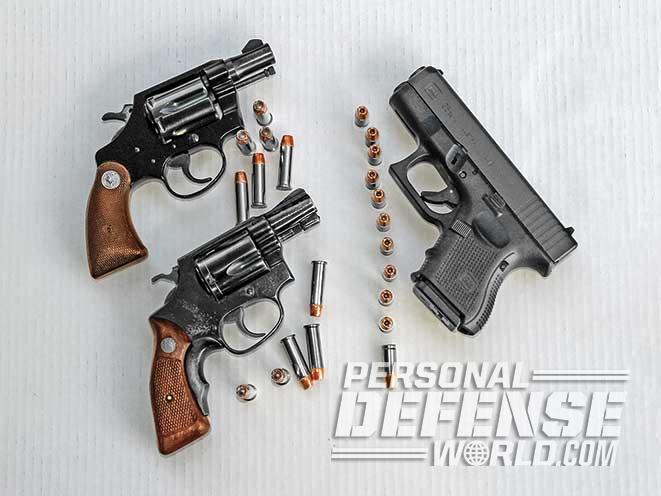A while back, I wrote about defending my Stock Service Revolver championship at the South Mountain regional IDPA match in Phoenix, Arizona, and mentioned that several other six-gunners were on my squad. I called us “a gaggle of wheelgunners.” On a shooting forum I frequent, someone said “gaggle” was for geese and that we needed a better word. I proposed “a museum” of revolver shooters. I was trumped, though, by gun-wise lawyer Erich Martell, who proposed “a mausoleum” of revolver shooters.
And yet gun dealers tell me that snub-nose, small-frame .38 and .357 revolvers continue to be some of their best sellers. A Western police department that has issued autoloaders since most of its oldest lawmen were rookies recently bought a huge number of .38 Special Smith & Wesson Model 642 snubbies as backups for its armed personnel. I recently ran two classes in which the top shot in each also happened to be the lone wheelgunner in each. Both used S&W L-Frames, one a blue Model 586 and the other a stainless Model 686.
Not too long ago, a USPSA Master shooter in Florida, known locally for his skill, was involved in a shootout with multiple armed robbers. Long story short, he survived unscathed and even prevailed. The gun that saved his life? A little S&W J-Frame revolver—because it was too hot and uncomfortable that day to carry his trademark gun, a big, customized .45 auto.
Advertisement — Continue Reading Below
There are reasons why so many see the revolver as obsolescent, but there are also reasons why it has risen from the dead and still walks among us. Let’s examine some of these reasons.
Firepower

Semi-autos win this category. There’s no question about it. They hold more rounds and can be reloaded faster. Duty pistols like the Glock 17 and S&W M&P9 will give you 18 rounds of 9mm ammo at the tip of your trigger finger, literally three times the capacity of the sixgun of yesteryear. The little 9mm Glock 26 auto holds 11 rounds. You’d have to combine a five-shot S&W and a six-shot Colt to equal that in compact revolver technology.
Advertisement — Continue Reading Below
- RELATED STORY: GLOCK Guardians – 4 Reliable Concealed Carry Pistols
With bad guys jacked up on drugs, wearing body armor, traveling in packs and knowing how to take cover—any of which can quickly drain the good guy’s ammo reservoir—this is a factor to consider. It’s probably the key reason for the autoloader’s ascendancy in both the police and the civilian markets.
Handling
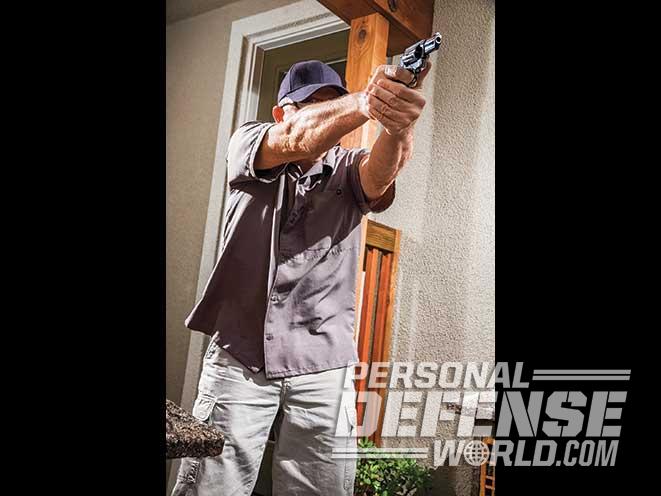
Advertisement — Continue Reading Below
Revolvers have the advantage here. Every year we still see the unfortunate effects of negligent discharges when inexperienced users remove their autoloader’s magazine and don’t quite realize that there’s still a live round in the chamber. It’s harder for ammo to hide from the shooter in a revolver’s cylinder.
With hammer-fired autos, many people lack the strength to retract an auto’s slide against the resistance of its recoil spring and the considerable force of the mainspring that’s holding the hammer down against the slide. But a touch of the thumb to the cylinder latch and some gentle fingers pressing against the cylinder and voila! The cylinder of the revolver is open for loading, unloading or inspection. It’s something new shooters and debilitated shooters alike find more comfortable.
Accuracy
Advertisement — Continue Reading Below

Another win for autos. When the Illinois State Police became the first major department to adopt an autopistol back in 1967, their hit ratio in shootings leaped from about 25 percent with the .38 and .357 revolvers they’d been carrying to 65 percent with their new 9mm semi-autos. This was attributed largely to the easier trigger pull after the first double-action (DA) shot. (Some troopers noticed that a disproportionate number of the misses with their DA/SA semi-autos involved the first DA shot.) While 9mm qualification scores were at first slightly lower than with the 4-inch and longer duty revolvers the troopers were long familiar with, they were dramatically better than the same troopers’ scores with the smaller .38s they had used for off-duty wear.
- RELATED STORY: 21 Ultra-Concealable, High-Powered Snub-Nose Revolvers
Comparing compact and subcompact revolvers with compact and subcompact autos, we still see a “shootability” factor that dramatically favors the auto. The autoloader seems to twist much less in the shooter’s hand upon recoil, even in comparable calibers and weights. For perspective, several Glock Sport Shooting Foundation (GSSF) events have been won with the Glock 26, beating scores fired by all the top shots, including those same shooters with larger Glock pistols. In all my years of Police Pistol Combat (PPC) revolver shooting, I only once saw a snub-nose revolver beat all the 4-inch-barreled guns in a service revolver match, and on that day the snubbie in question was a big Reeves Jungkind-tuned Colt Python with a 2.5-inch barrel—not exactly a pocket handgun.
Carry Considerations
Advertisement — Continue Reading Below

Revolvers shine here. Pocket carry usually means the front trouser pocket. Because different pants are cut with their pockets at different angles—patch pockets, slash pockets and everything in between—anyone who doesn’t wear the same-style trousers day in and day out has to worry about whether their draw will snag on the edge of the pocket, perhaps fatally stalling their presentation of the weapon when they need it desperately for self-defense.
Most pocket autos have a square back at the rear of the slide, a possible snag point. A “hammerless” revolver, a design going back to the S&W New Departure Safety Hammerless introduced in 1887, prevents that from happening. So does a revolver with a shrouded hammer, as seen on the Colt hammer shrouds introduced in the mid-20th century or the built-in version found on the original S&W Bodyguard revolver dating back to the mid-1950s. You can also go with a spur-less external hammer, or simply “bob off” the spur on a revolver with a conventional exposed hammer. Finally, by simply placing the thumb on the hammer spur, your thumb can serve as a hammer shroud.

You can try to do the same with an auto, but the rear of the gun is so far back that your thumb is bent into a weak grasp, forcing you to re-grip the pistol once it clears the pocket. With a revolver, even if you’re using your thumb to “shroud” a hammer spur, no time is lost bringing the thumb down in a simple movement as you bring the gun up into the firing position.
Advertisement — Continue Reading Below
- RELATED STORY: Concealed Carry Guns – Top 10 Pistols & Revolvers For Backup
Of course, an auto can lie flatter in the pocket and hold more ammo. I personally don’t find the concealment difference significant. But the draw speed difference is another story. Having pocket-carried many autos, all the way up to the .45-caliber Glock 30 in some capacious trousers, I’d still rather have a revolver’s five or six shots right now than an auto’s seven to 11 shots an extra second from now.
What about ankle carry? An auto’s rearward-projecting slide is less likely to clear the pants cuff in an emergency draw than the sloping, low-profile surface of a hammerless revolver. And while your pockets might be full of lint, ankle holsters are prone to collecting dust because of their proximity to the ground. Some compact autos have tolerances that can survive this, but many don’t and will jam on lint accumulated between the slide and slide rails once the shooting starts. Revolvers just chew up the dust bunnies and keep on shooting when drawn from an ankle holster.
From The Hip
Advertisement — Continue Reading Below

Comparing handguns with similar footprints, the autoloader tends to conceal better and more comfortably than the revolver when carried on or slightly behind the hip, or even in the appendix position. The reason is its flatter overall profile. Even a small revolver still has a big, chunky cylinder. Outside the waistband, it’s a bulge point; inside the waistband, it can be a comfort issue. Since the year of its introduction, the 1911 has proven itself comfortable for all-day wear inside the waistband due to its flat profile.
My friend Katie Krueger, a gun shop owner, pistol champion and firearms instructor, tried everything from snubbie .38s to assorted semi-autos and never found something comfortable enough to carry all day inside the waistband until she tried the slim Smith & Wesson M&P Shield semi-auto.
Contact Shots
Advertisement — Continue Reading Below

Revolvers win in this category, too. A cop I know recently retired after three-plus decades of police work in a major city, and many gunfights. In the very first of those, a would-be killer wrestled with him, belly to belly, trying to bring his weapon to bear, and my friend rammed the muzzle of his S&W revolver into the man’s center chest and pulled the trigger. The press-contact shot sent the muzzle blast into the attacker’s thorax along with the bullet, killing him instantly.
Many autoloaders would have been pushed out of battery by that kind of desperate pressure, activating the trigger disconnector and preventing the good guy’s gun from firing. There are a very few autoloaders that are immune to this because of their design. Springfield’s XD series pistols will work at press-contact. Another notable example is Beretta’s Nano.
But any contemporary revolver will fire every shot at press-contact. Even the autos that will go off when you need them to in that situation can be jammed by viscous blood and flesh globules being blasted back into the barrel bushing area as the slide cycles from the first shot. I know of at least one case where that happened in an actual gunfight, costing an officer his life. He instantly dropped his first attacker with his 9mm auto, but was shot fatally by the second because his gun didn’t work when he pulled the trigger again. With a revolver, he would have been able to continue firing.
Felt Recoil
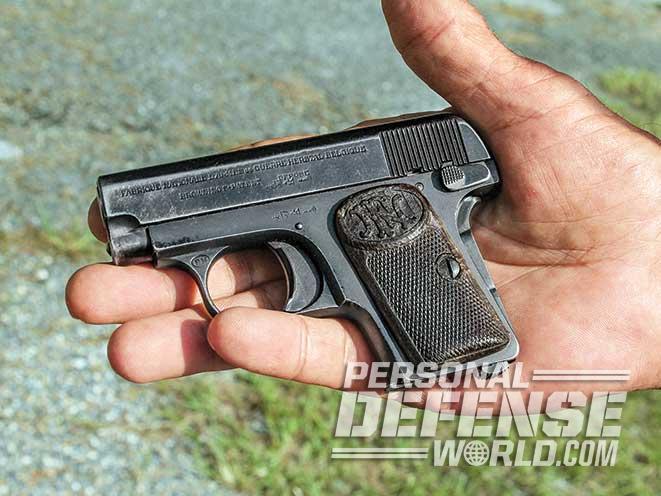
Semi-autos have the advantage here. With a low bore axis, a mechanism that soaks up some of the recoil through its spring-loaded cycle and a grip shape that’s not particularly conducive to twisting in the hand when a gun kicks, the autoloader’s recoil is distinctly more controllable than the revolver’s if we’re assuming similar sizes, weights and power levels. A snub-nose .38 can be uncomfortable while still being controllable in experienced hands with +P ammo, while a subcompact 9mm at the same power level is a pleasure to shoot by comparison. My Glock 33 in .357 SIG is distinctly snappier in recoil than its 9mm twin, the Glock 26, but it’s more challenging than unpleasant. By contrast, when I carry my 14-ounce S&W M&P340 revolver, it’s loaded with .38 Special +P ammo because the damn thing hurts with .357 Magnum loads. With a snubbie .357 Mag revolver or a subcompact .357 SIG auto, you’re talking a 125-grain bullet in the 1,300-fps range either way. The auto is simply more comfortable than the revolver.
And The Winner Is…
Of course, there are other issues to consider. For example, revolvers are less likely to malfunction when fired through a coat pocket, and spare ammunition for autopistols is not only faster to insert into the gun via spare magazines, but the magazines are more comfortable and convenient to carry than revolver speedloaders. All that said, you get the idea—there are advantages and disadvantages to carrying both revolvers and semi-autos concealed.
Only you can choose, based on your particular needs and preferences. But you can see why the revolvers vs. semi-autos argument is not likely to die soon in the concealed carry handgun world.
This article was published in ‘Pocket Pistols’ #186. For information on how to subscribe, please email subscriptions@
